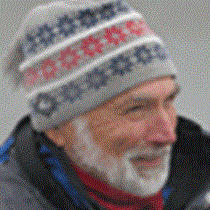Isla San Marcos & Santa Rosalia
Our morning started with a thrilling experience. Fish were rising close to the surface and bringing in pelicans, Heermann’s gulls and terns. They soon dropped, leaving the birds floating and waiting in concentrated masses until the fish rose somewhere else. A few would see more fish rise elsewhere, drop into them and attract more birds. There were also two fin whales that appeared and then started to feed near the birds. These animals, second only to the blue whale in size, were a shiny black in the early morning light. Their tall blows hung in the still air as they cruised side by side. After a few minutes below, they emerged at the surface in lateral lunges.
These baleen whales usually gulp in enormous amounts of food and water by opening their mouths and allowing water filled with food to expand their throats. They then close their lower jaws until they meet the 350 to 400 baleen plates on each side of the upper jaws. This frayed, fingernail-like material acts like a strainer capturing either fish or more commonly krill within the mouth as the water is forced out. They eat up to a ton a day in this highly efficient manner, usually underwater and out of sight, but not today.
The photos show how lateral-lunge feeding occurs at the surface. When food is concentrated within a few feet of the top, fin whales and several other species roll over on their right sides, swim through their prey, open their mouths and the food pours in with the water. With a forward motion, the water pressure helps expand the throat. The first photo is of the upper jaw on the right with the baleen as a brownish fringe facing away. The lower jaw has expanded from the water pressure, and excess water is pouring out of the corner of the mouth. The expanding throat pleats are on the other side of the lower jaw and can’t be seen in this photo but are visible in the second image. This view is from the underside and shows the distended throat as the whale passes to the left. The white underside of the flipper is at the far right.
We hiked on Isla San Marcos after breakfast and toured an interesting shoreline in Zodiacs. We later went ashore in Santa Rosalia, a mining and fishing town with interesting wooden buildings, a lack of tourism and friendly people who have an indifferent attitude about our being there.
We cruised north in the late afternoon and soon found both a fin and a blue whale. We spent more time with the blue because of our previous encounters with feeding fin whales. It was wonderful to see this species with its mottled blue-gray color and tiny dorsal fin. As we motored north during the last light before dinner, several other whales spouted in the distance.
Our morning started with a thrilling experience. Fish were rising close to the surface and bringing in pelicans, Heermann’s gulls and terns. They soon dropped, leaving the birds floating and waiting in concentrated masses until the fish rose somewhere else. A few would see more fish rise elsewhere, drop into them and attract more birds. There were also two fin whales that appeared and then started to feed near the birds. These animals, second only to the blue whale in size, were a shiny black in the early morning light. Their tall blows hung in the still air as they cruised side by side. After a few minutes below, they emerged at the surface in lateral lunges.
These baleen whales usually gulp in enormous amounts of food and water by opening their mouths and allowing water filled with food to expand their throats. They then close their lower jaws until they meet the 350 to 400 baleen plates on each side of the upper jaws. This frayed, fingernail-like material acts like a strainer capturing either fish or more commonly krill within the mouth as the water is forced out. They eat up to a ton a day in this highly efficient manner, usually underwater and out of sight, but not today.
The photos show how lateral-lunge feeding occurs at the surface. When food is concentrated within a few feet of the top, fin whales and several other species roll over on their right sides, swim through their prey, open their mouths and the food pours in with the water. With a forward motion, the water pressure helps expand the throat. The first photo is of the upper jaw on the right with the baleen as a brownish fringe facing away. The lower jaw has expanded from the water pressure, and excess water is pouring out of the corner of the mouth. The expanding throat pleats are on the other side of the lower jaw and can’t be seen in this photo but are visible in the second image. This view is from the underside and shows the distended throat as the whale passes to the left. The white underside of the flipper is at the far right.
We hiked on Isla San Marcos after breakfast and toured an interesting shoreline in Zodiacs. We later went ashore in Santa Rosalia, a mining and fishing town with interesting wooden buildings, a lack of tourism and friendly people who have an indifferent attitude about our being there.
We cruised north in the late afternoon and soon found both a fin and a blue whale. We spent more time with the blue because of our previous encounters with feeding fin whales. It was wonderful to see this species with its mottled blue-gray color and tiny dorsal fin. As we motored north during the last light before dinner, several other whales spouted in the distance.




